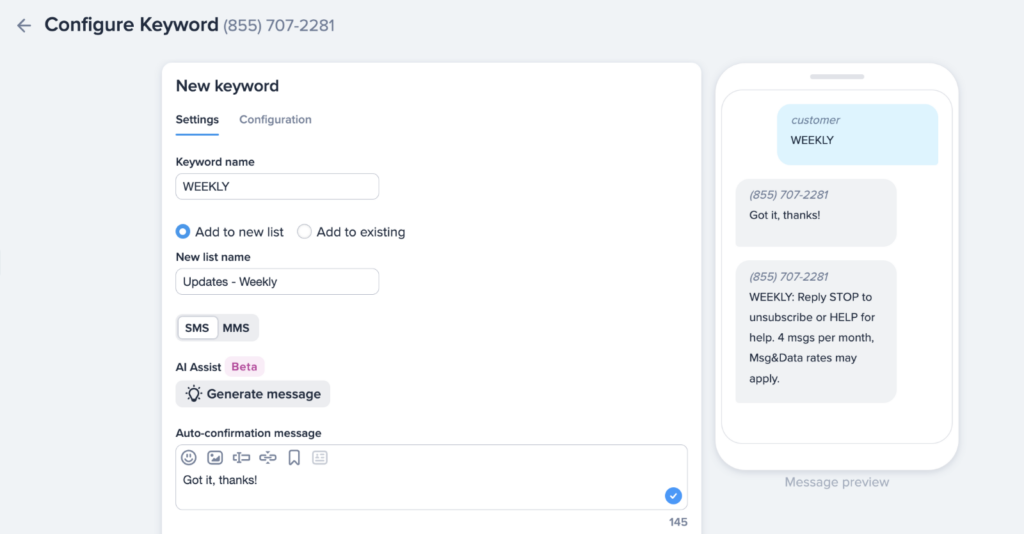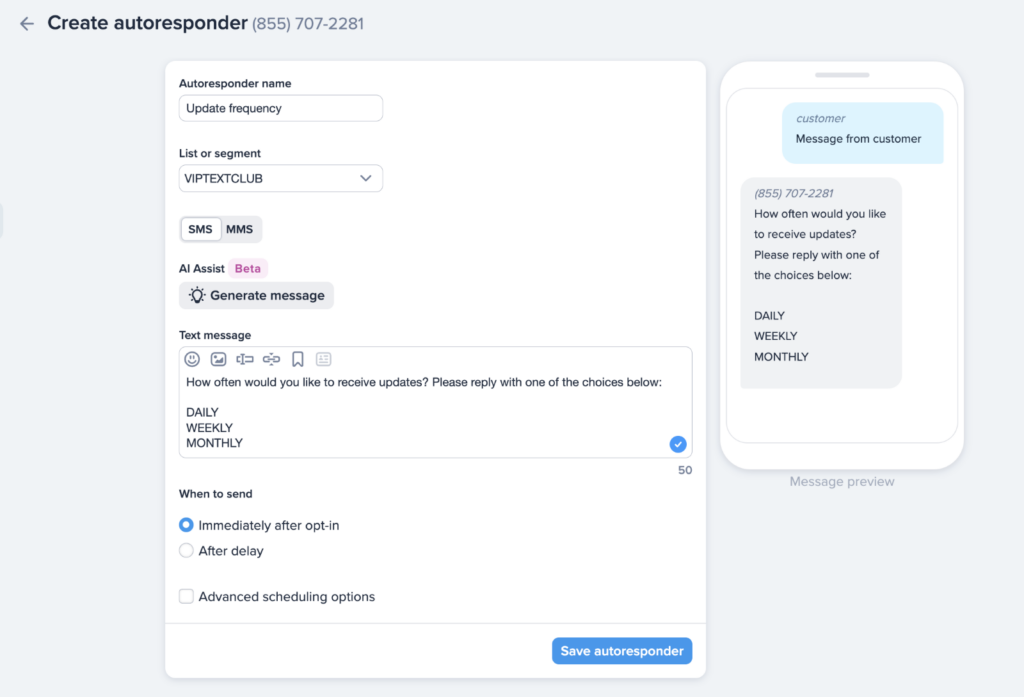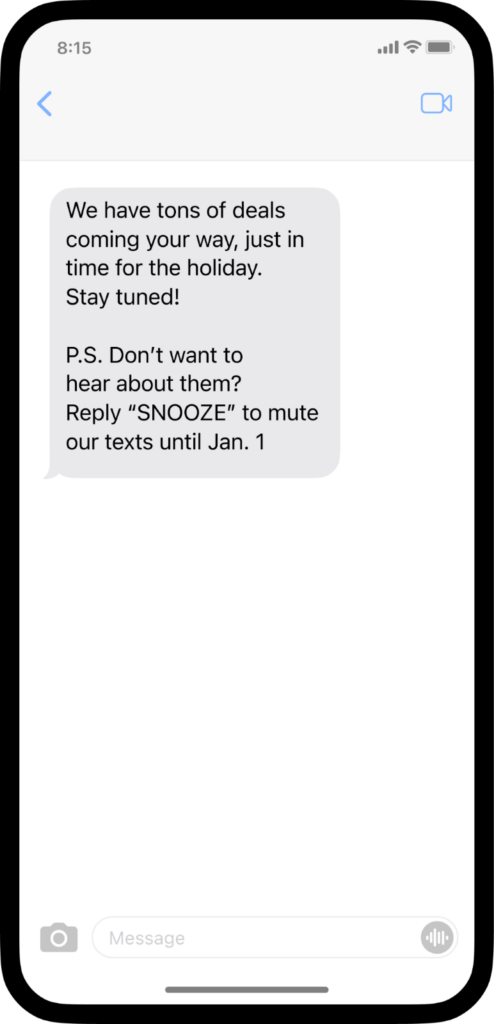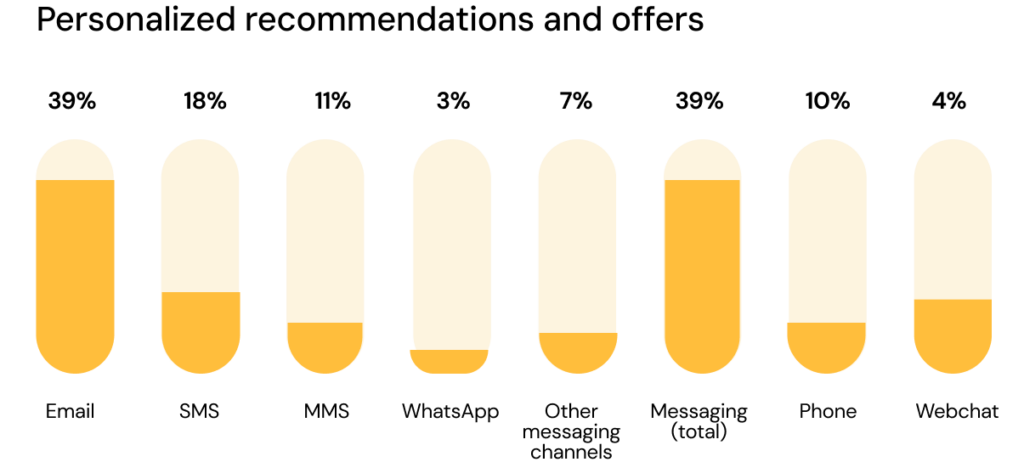Understanding SMS frequency: Are you texting customers too much?
No business wants to annoy customers with too many texts. So, how do you get your SMS sending frequency right? Get our advice and explore new consumer research from Sinch.

No business wants to annoy customers with too many texts. So, how do you get your SMS sending frequency right? Get our advice and explore new consumer research from Sinch.

After a first date with someone special, it can be tempting to send too many texts. That kind of desperation could easily scare them away. Here’s the thing… Businesses can make the same sorts of mistakes with SMS frequency and their customers.
You could certainly be texting customers too much, and new consumer research from Sinch suggests overdoing it is a major dealbreaker for plenty of people.
Like Goldilocks traipsing through the three bears’ home, complaining about porridge and chairs, the people who sign up for your texts expect you to get SMS marketing frequency just right. Here are some insights and advice on how to make that happen.
TABLE OF CONTENTS
Our friends at Sinch surveyed hundreds of U.S consumers to find out how they prefer to connect and communicate with brands. You can see the full results in the report The art and heart of meaningful customer connections.
When asked what could ruin their impression of a brand during initial interactions, consumers responded loud and clear. More than 50% said getting either too many messages or irrelevant communications prompts them to opt out.

26% of respondents said receiving messages too frequently was the biggest dealbreaker while 25% felt that way about irrelevant messages. However, you’ll also notice that 9% of consumers consider it a problem if a business doesn’t communicate with them often enough.
So, there must be a sweet spot, right? Is there a way to send the perfect amount of text marketing campaigns to people without aggravating anyone or leaving them in the dark?
As you may have already guessed, perfecting your SMS frequency can be a bit complex. That’s partly because we all have our own preferences for what’s just right. But it also depends on your industry, target audience, customer buying cycle, and much more.
Some of the most interesting findings in Sinch’s report involve comparisons of what businesses are doing to what consumers say they want. When asked about preferences for receiving promotional messages, consumer opinions were varied, and they don’t always align with sending frequencies.

More than a third of U.S consumers say they want to hear about promotions whenever they come up. That’s a good percentage of people who are likely to be interested and engaged in your campaigns. However, nearly half of businesses (48%) are sending promotional campaigns as often as they want. This indicates there are customers getting more messages than they bargained for. They’ll be the ones texting “STOP” to put an end to those excessive or unwanted promotional messages.
Around 25% of respondents said they want to be contacted about promotions no more than daily and 26% said no more than weekly. That’s more than half when combined. This might suggest that sending promotional SMS campaigns once or twice a week is that Goldilocks-style sweet spot for SMS frequency.
But be careful about making too many assumptions. A biweekly SMS cadence might be appropriate for some businesses or specific campaigns – but not others. For example, bi-weekly promotional texts from someone’s favorite grocery store could be helpful because they shop there so often. On the other hand, if someone receives weekly texts from a travel brand, and they only take one vacation a year, it could get annoying.
Likewise, receiving a couple of texts per week from you may be the right frequency for certain customers while others prefer less frequent communication. This is why you need to start getting more strategic with SMS communication.

Our own Dani Henion hosted a webinar on optimizing your SMS sending frequency. She offered some solid advice for understanding how to deliver what your customers really want. Check out the recording of Getting your SMS frequency just right to see for yourself.
These are our top tips for avoiding issues with SMS frequency:
Identifying the right SMS frequency should start when customers opt in to receive your texts. If you’re delivering daily deals or weekly tips, make that obvious from the get-go. Landing pages and signup forms can clearly state how often you’ll be texting customers. You can even use the frequency as a benefit:
“Don’t miss our daily deals! Get savings delivered straight to your phone.”
Welcome text messages present another opportunity to set clear expectations for SMS frequency. The first message new subscribers receive after opting in can remind them of what they can look forward to receiving as well as how to opt out if they change their minds.
The graphic below illustrates how a brand could use a social promotion or digital ad to plainly state the frequency of “weekly store updates and deals.” When a new subscriber uses the keyword to opt in, an automated welcome message could reiterate the weekly cadence.

You can also let people choose the promotional text message frequency that’s right for them. If you provide options for how often you’ll send SMS campaigns at signup, you can easily segment those subscribers into groups with different sending cadences.
But what if you already have a big list of subscribers and you’re unsure what they prefer? Try using SMS keywords paired with an autoresponder. For example, send your list a message asking them to reply with “DAILY”, “WEEKLY”, or “MONTHLY” to indicate how often they want to hear from you.
STEP ONE: Create separate keywords for each frequency option (like daily, weekly, and monthly). Add each to a new list so you can select it when you’re creating new SMS campaigns.

STEP TWO: Set up an autoresponder asking how often the contact wants to receive your messages, and list each option based on the keywords you created.

Note: this only works for new contacts, since autoresponders are triggered by opt-ins. If you want to ask current subscribers about their frequency preferences, send a regular SMS campaign
Now, when you are ready to send campaigns based on frequency, you can select contact lists that correspond to the keywords you created.
Of course, your segmentation strategy can extend way beyond your customers’ appetites for receiving texts. Get our advice for segmenting different types of customers with thoughts on what you should text each group.
Keep a close eye on SMS marketing metrics to understand whether you’re hitting the right frequency or not. Dani told webinar attendees there are some important KPIs to measure which serve as warning signs that customers are getting tired of your texts.
The biggest telltale sign you’re texting customers too often is the percentage of people who opt-out. While it’s perfectly natural for some customers to choose to unsubscribe, keep your eye out for changes in typical unsubscribe rates.
Let’s say it’s normal for less than 1% of your list to opt out during a campaign. Then you increase your SMS frequency, and the unsubscribe rate suddenly spikes to more than 10%. That’s a problem, and you should consider adjusting your sending cadence.
SMS campaigns have notably high open rates compared to channels like email. But if you see this metric starting to slide, it could be a sign you’re sending too many texts. Perhaps your customers aren’t opening these messages because they already got the point and just aren’t interested. If that’s the case, adjusting your SMS frequency will reduce waste.
You should also monitor click rates and conversions for SMS promotions. If you’re sending follow-up messages as part of a major campaign, it’s reasonable to expect a decline in engagement. However, if the drop is dramatic, consider adjusting the cadence.
Here’s a sign of text message fatigue you can’t ignore: Recipients straight up tell you they’re sick of all the texts from your businesses.
Two-way communication is one of the biggest advantages of SMS. Of course, it also means you’ll get negative responses from time-to-time, including complaints about how often you’re texting.
Let’s say you only get a few of these kinds of complaints. It’s easy to brush those subscribers off as “Negative Nancies” who just don’t get it. The truth is, they may be doing you a favor.
Some often-cited research from Lee Resources suggests that for every customer who complains about a problem, 26 others feel the same way yet remain silent. If your SMS frequency is annoying customers, most will just unsubscribe instead of reaching out to complain. So, it may be wise to heed the warnings of the Negative Nancies on your list.
Putting more power into the hands of your customers is an excellent way to show you have their interests top of mind. One way to do that is to provide them with the ability to pause promotional SMS messages for a set time.
Use an SMS keyword such as “SNOOZE” or “PAUSE” to temporarily exclude recipients from those communications. When someone replies to your text with the keyword, they’ll be added to a new contact list. Then, when you create a new text campaign, you can exclude this list from your recipients.

This lets customers take a break until they’re ready to start engaging with your texts again. It’s a nice compromise from completely opting out when someone just doesn’t want to hear from you for a little while.

The Customer Connections report from Sinch shows that the text message inbox is one of the best places to deliver personalized promotions. When you combine consumer preferences for receiving personalized recommendations via SMS and MMS, only email is more preferred. Combining all mobile messaging channels leads to a tie with email.

A total of 29% of consumers said they’d prefer receiving personalized recommendations via SMS or MMS messages while 39% would pick their email inbox.
Here’s another important consideration. Preferences for mobile messaging are likely to grow as younger consumers come of age. SimpleTexting’sOur research on text marketing trends found 85% of Gen-Z consumers have opted in to receive texts from businesses. This generation of consumers consists of people in their teens and twenties. Their purchasing power will grow in the coming years. Our research into the state of small business marketing also found Gen-Z is the generation most likely to prefer text communication and least likely to want emails from brands.
Delivering personalized experiences through text marketing is ideal no matter the age of your customers. That’s because it’s already a very personal and conversational communication channel. Check out our guide on when and how to send personalized text messages.
It’s no coincidence that Sinch’s findings reveal the impact of not only message frequency but also the importance of relevant communications. These two factors are directly connected. When you’re consistently texting customers relevant messages, they’re less likely to have problems with how often they hear from you.
Segmentation and personalization are two effective ways to deliver relevant SMS marketing, but you can also diversify your approach with a tasty variety of text message campaigns. In our webinar, Dani Henion suggests using the PASTA framework, which includes five types of text campaigns that deliver value to customers:
Check out our PASTA menu for some example text messages:

When every message you send pushes a promo code or a weekly deal, your SMS marketing may start getting stale. Spicing up your strategy with the PASTA framework helps you stay relevant.
Could your customer communication strategy use an upgrade or are you already nailing it? Our friends at Sinch are offering a free, personalized evaluation to help you find out if there are other ways for you to connect with your customers.
There’s an ideal marketing mix for every industry, small business, and customer base. Take the test today and find out how you could improve your approach to customer communication.

Kasey Steinbrinck produced television and radio programming and wrote for an award-winning local newspaper before learning the ways of content marketing. Since then, he's helped organizations ranging from IT and manufacturing to B2B and B2C SaaS companies reach their target audiences with a cohesive content strategy based on strong storytelling. He currently works in marketing for Sinch.
More Posts from Kasey SteinbrinckWe surveyed 1,000 U.S. consumers as well as 400 business owners and digital marketers to glean key texting insights for 2025.
ReadWe surveyed 1,400 consumers and businesses to glean key texting insights for 2024. Here's what we found.
ReadStart a text marketing campaign or have a 1-on-1 conversation today. It's risk free. Sign up for a free 14-day trial today to see SimpleTexting in action.
No credit card required